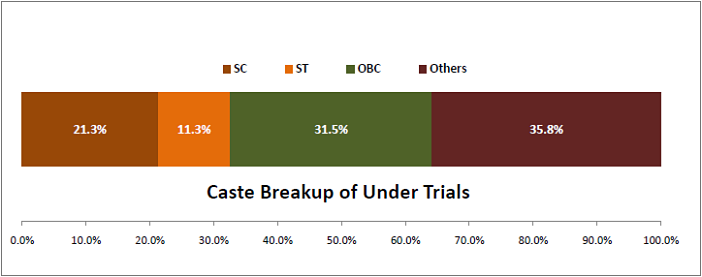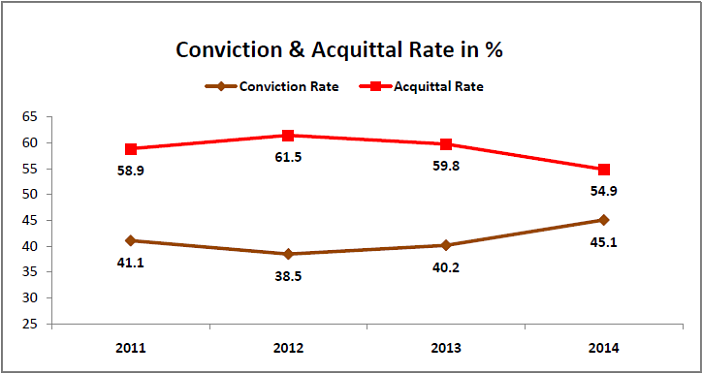[orc]According to the Prison Statistics of the National Crime Records Bureau(NCRB) for the year 2013, Indian Prisons are overcrowded with occupancy ratio of 18% more than the capacity. More than 2/3rd of the inmates are undertrials. Section 436A of CrPC provides for the maximum period for which an under trial can be detained. An under trial prisoner has to be released on bail with personal bond, after serving for more than half of the maximum punishment. Despite advisories by the MHA & directions from the supreme court, state governments have not acted.
The National Crime Records Bureau (NCRB) statistics indicate that our prisons across the country are overcrowded. The all India average occupancy ratio of our prisons is 118.4%, 18% more than the capacity of the prisons. And not surprisingly, 2/3rd of the inmates are under trials, thanks to the slow pace of our judicial process. But there are ways to decongest our jails, provided our governments are interested.
The Prison Numbers & Caste Breakup
As per the NCRB, at the end of 2013, the total numbers of jail inmates is 4,11,992 out of which 2,78,503 were under trial prisoners. This is a whopping 2/3rd of the total inmates. 
Nearly one third (1/3rd) of all these under trials belong to SCs/STs. Another 32% of them belong to the OBCs while the rest make up the remaining 36%. It is clear from these statistics that the poor and the disadvantaged are often at the receiving end spending long years in jails.
Travesty of Justice
It is a travesty of justice when majority of these under trials are acquitted by courts as and when the trials are complete. If the last four years are any indication, more under trials are acquitted than the ones who are convicted. In 2011, while the acquittal rate was 59%, the conviction rate was 41% for all IPC crimes. (Out of all the cases where the trial is complete). In 2012, the acquittal rate went up to 62% while the conviction rate was just 38%. In 2013, the acquittal rate was 60% while the conviction rate was just 40%. The conviction rate went up to 45% in 2014 while the acquittal rate stood at 55%. In other words, more than half the people who spend their time in prisons while the trial is on are finally acquitted. Large numbers of cases take years for the trial to be complete and the accused spend all that time in the prison.
Is there a law to prevent this?
The Parliament in its wisdom has amended the Code of Criminal Procedure (CrPC), 1973 by inserting a new section 436A. This was done in 2005. This section defines the maximum period for which an under trial prisoner can be detained in jail. Section 436A of CrPC reads
“436A. Maximum period for which an under trial prisoner can be detained – Where a person has, during the period of investigation, inquiry or trial under this Code of an offence under any law (not being an offence for which the punishment of death has been specified as one of the punishments under that law) undergone detention for a period extending up to one-half of the maximum period of imprisonment specified for that offence under that law, he shall be released by the Court on his personal bond with or without sureties. 
In other words, an under trial prisoner (UTP) has the right to seek bail on serving more than one half of the maximum possible sentence on their personal bond. No person can be detained in prison as an under trial for a period exceeding the maximum possible sentence. This provision is, however, not applicable for those who are charged with offences punishable with the death sentence.
What is the situation now?
Prisons and prison administration is a state subject under the seventh schedule of the constitution. Hence the Ministry of Home Affairs (MHA) has been sending advisories to state governments to ensure the implementation of this section. The Union Home Ministry has sent guidelines in 2011, 2013 & also 2014.
In its advisory, the MHA noted that only the poor and indigent who have not been able to put up the surety are those who have continued to languish as under-trials for very long periods and that too for minor offences. The advisory also noted that the lack of adequate legal aid and a general lack of awareness about rights of arrestees are principal reasons for the continued detention of individuals accused of bailable offences, where bail is a matter of right and where an order of detention is supposed to be an aberration. Thus a disproportionate amount of our prison-space and resources for prison maintenance are being invested on Under Trial Prisoners (UTPs) which is not sustainable.
Hence in January, 2013, the MHA asked the state governments to consider taking the following actions
- Constitute a Review Committee (URC) in every district with the District Judge as Chairman, and the District Magistrate and District SP as members to meet every three months and review the cases.
- Jail Superintendent should conduct a survey of all cases where the UTPs have completed more than one-fourth of the maximum sentence. He should prepare a survey list and send the same to the District Legal Service Authority (DLSA) as well as the UT Review Committee.
- Prison authorities may educate under trial prisoners on their rights to bail.
- Provide legal aid – may be provided through empanelled lawyers of DLSA to cases presented for release on bail and reduction of bail amount.
- The list should be made available to the non-official visitors as well as District Magistrates/Judges who conduct periodic inspections of the jails.
- Home Department may also develop management information system to ascertain the progress made jail-wise in this regard.
The MHA asked the states to do this with immediate effect. Most states did not constitute a review committee as advised by the MHA.
The Supreme Court’s Intervention
The Supreme Court in September, 2014 in the case of ‘Vijay Aggarwal v. Union of India & Ors’ issued the following directions relating to UTPs
- Jurisdictional Magistrate/Chief judicial Magistrates/Sessions Judge shall hold one sitting in a week in each jail/prison for two months commencing from 1st October, 2014 for the purposes of effective implementation of Section 436A of the Code of Criminal Procedure.
- In its sitting in jail, the above judicial officers shall identify the under trial prisoners who have completed half period of the maximum period or maximum period of imprisonment provided for the said offence under the law and After complying with the procedure prescribed under Section 436A pass an appropriate order in jail itself for release of such under trial prisoners who fulfill the requirement of Section 436A for their release immediately.
- Such jurisdictional Magistrate/Chief Judicial Magistrate/ Sessions Judge shall submit the report of each of such sitting to the Registrar General of the High Court and At the end of two months, the Registrar General of each High Court shall submit the report to the Secretary General of this Court without any delay. To facilitate the compliance of the above order, we direct the jail Superintendent of each jail/prison to provide all necessary facilities for holding the court sitting by the above judicial officers.
Even in May 2015, the Supreme Court directed the National Legal Services Authority to coordinate with the Union Home Ministry to ensure urgent review of such UTP cases for granting them bail. A Social Justice Bench of Justices Madan B. Lokur and U.U. Lalit noted that 67 per cent of those lodged in the prisons in the country are under trials who are too poor to get bail, the Supreme Court has. It has given one month to ensure the functioning of the under trial Review Committee in every district in the country.
The MHA issued another advisory in which it explained the calculation of half the maximum possible sentence in cases where a person is accused of multiple offences and under multiple sections of the IPC.
Even after all these advisories, under trials and especially those from the disadvantaged sections of society continue to languish in jails while their trials drag on for years, often for petty offences. We could decongest our jails and provide relief to lakhs of under trials provided our governments are willing to implement the law.
What can we do?
We could use the RTI act to understand what is happening in our respective states. That will at least push the state governments to act. We could ask for the following information from the state governments based on the advisory by MHA.
- Whether Review Committee has been set up in the Districts? If so, names, contact numbers and designations of all members of the committee, if not constituted reasons for the same.
- Whether jail superintendent has completed the survey of cases where the UTPs have completed more than one fourth of the maximum sentence and sent it to District Legal Services Authority and UT Review Committee, details thereof,
- Whether UT prisoners were duty informed about their rights to bail, details thereof,
- Whether Legal Aid was provided to them for getting released on bail and reduction of bail amount,
- Whether list was made available to the nonofficial visitors as well as District Magistrates/Judges
- Whether Management Information System has been developed?
One Ms. Divya Iyer filed an application under RTI with the Tihar Jail authorities. The case went up to the Central Information Commission and the CIC in a detailed order, directed the home department officials to issue directives to all jail authorities.





3 Comments
Pingback: Read, Learn, Improve – 12-Sept-15 | Random Thoughts of Analyst
Pingback: Interesting Read : What I learned this week Sept 15, 2015 | Valuenomics
Pingback: More than 70% of the under-trial prisoners are illiterate or have studied only up to Class X - Fact Checking Tools | Factbase.us